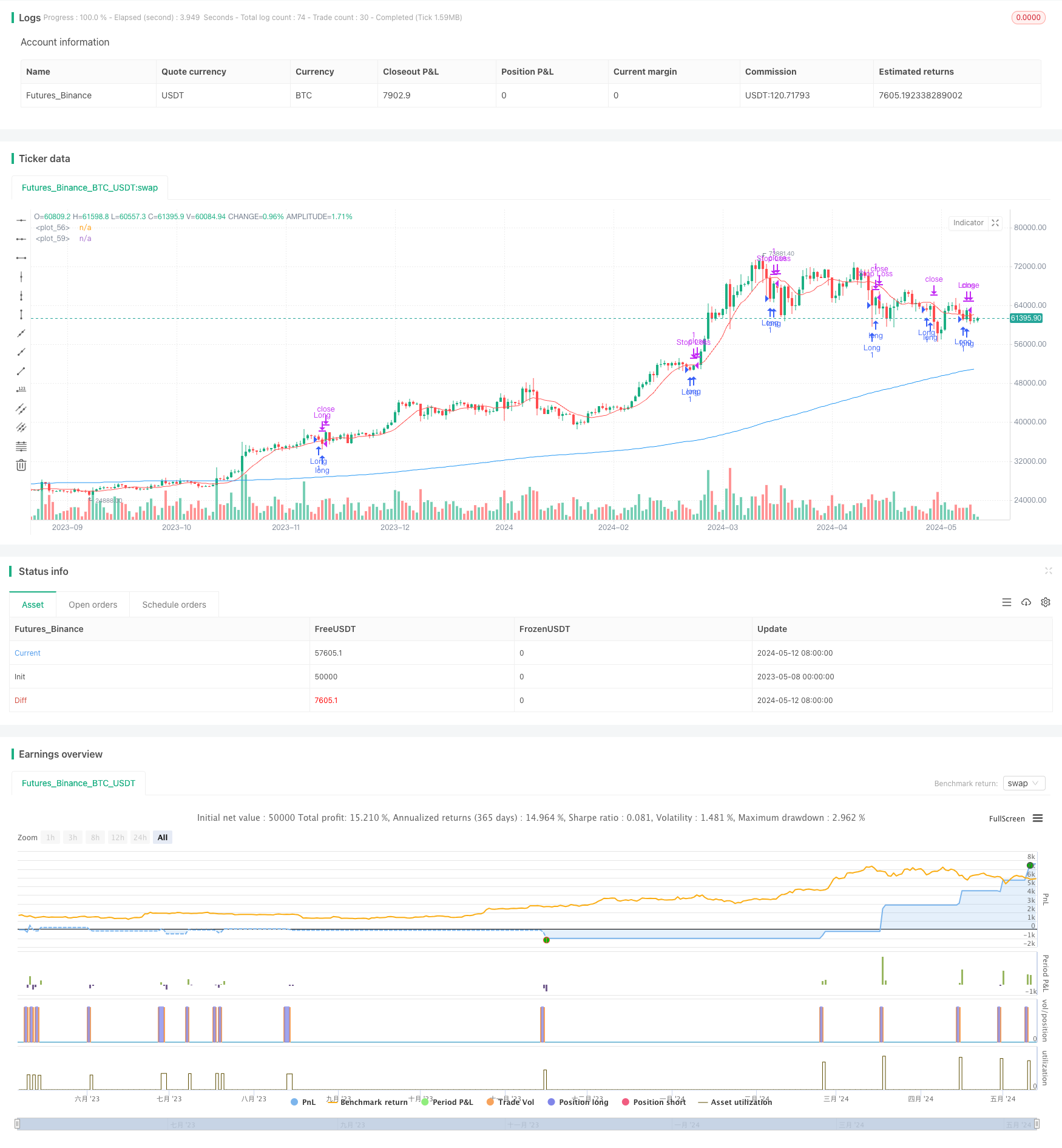
概述
该策略是一个基于连续三根阴线和双均线的交易策略。策略的主要思路是:当连续出现三根阴线,并且当前收盘价高于200日均线时,开仓做多;当10日均线与价格发生交叉,或者价格达到止盈或止损点位时,平仓。该策略只在指定的时间范围内运行。
策略原理
- 计算连续阴线的数量。如果收盘价下跌,连续阴线数加1;否则,连续阴线数重置为0。
- 计算10日均线和200日均线。
- 判断当前收盘价是否高于10日均线。
- 判断是否满足进场条件:连续三根阴线、当前时间在指定范围内,且当前收盘价高于200日均线。
- 判断是否满足出场条件:10日均线与价格发生交叉,或者价格达到止盈或止损点位。
- 如果满足进场条件且当前无持仓,则开仓做多。
- 如果满足出场条件且当前有持仓,则平仓。
策略优势
- 考虑了价格走势和均线因素,能够在趋势和震荡行情中把握机会。
- 设置了止盈止损,可以有效控制风险。
- 限定了策略运行的时间范围,可以避免在某些特定时期承担过大风险。
- 代码逻辑清晰,可读性强,便于理解和优化。
策略风险
- 对于连续阴线的判断可能过于简单,容易引发错误信号。
- 止盈止损的设置可能不够灵活,在行情波动较大时,可能导致频繁交易或者错失机会。
- 对于突发事件、重大消息等非常规因素考虑不足,可能承担额外风险。
策略优化方向
- 可以考虑引入更多技术指标,如RSI、MACD等,构建更稳健的信号判断逻辑。
- 可以优化止盈止损的设置,引入动态止盈止损或者基于ATR等波动率指标的止损。
- 可以研究不同参数设置对策略的影响,如连续阴线根数、均线周期等,寻找最优参数组合。
- 可以加入仓位管理,根据不同市场环境动态调整仓位,提高资金利用效率。
总结
该策略通过连续阴线和双均线的组合,构建了一个简单易懂的交易模型。策略在把握趋势性机会的同时,也设置了一定的风控措施。但是,策略在信号判断和风险控制方面还有进一步优化的空间。通过引入更多技术指标、优化参数设置、动态止盈止损和仓位管理等措施,可以进一步提升策略的稳健性和盈利能力。
策略源码
/*backtest
start: 2023-05-08 00:00:00
end: 2024-05-13 00:00:00
period: 1d
basePeriod: 1h
exchanges: [{"eid":"Futures_Binance","currency":"BTC_USDT"}]
*/
//@version=5
strategy("Estrategia de Trading", overlay=true)
// Definir el número de cierres de velas decrecientes consecutivas
var int cierres_decrecientes_consecutivos = 0
num_cierres_decrecientes = input.int(3, title="Número de cierres decrecientes", minval=1)
// Definir el porcentaje de cambio para cerrar la operación
porcentaje_cierre_arriba = input.float(1.5, title="Porcentaje de cierre arriba (%)", step=0.1)
porcentaje_cierre_abajo = input.float(1.0, title="Porcentaje de cierre abajo (%)", step=0.1)
// Definir las medias móviles para el cierre de la operación
periodos_media_movil_cierre = input.int(10, title="Períodos de la media móvil para cierre")
periodos_media_movil_200 = input.int(200, title="Períodos de la media móvil de 200")
// Definir el rango de fechas para la simulación
start_date = timestamp(2024, 1, 1, 0, 0)
end_date = timestamp(2024, 12, 31, 23, 59)
// Calcular la media móvil para el cierre de la operación
sma_cierre = ta.sma(close, periodos_media_movil_cierre)
sma_200 = ta.sma(close, periodos_media_movil_200)
// Calcular si el precio está por encima o por debajo de la media móvil para el cierre de la operación
precio_por_encima_sma_cierre = close > sma_cierre
precio_por_debajo_sma_cierre = close < sma_cierre
// Calcular si se han producido num_cierres_decrecientes consecutivos
if (ta.change(close) < 0)
cierres_decrecientes_consecutivos := cierres_decrecientes_consecutivos + 1
else
cierres_decrecientes_consecutivos := 0
es_cierres_consecutivos = cierres_decrecientes_consecutivos >= num_cierres_decrecientes
// Definir condiciones de entrada y salida de la estrategia dentro del rango de fechas y con el precio por encima de la SMA de 200
condicion_entrada = es_cierres_consecutivos and close > sma_200
condicion_cierre_sma = (precio_por_encima_sma_cierre[1] and not precio_por_encima_sma_cierre) or (not precio_por_encima_sma_cierre[1] and precio_por_encima_sma_cierre)
// Calcular precios de salida basados en porcentajes
precio_salida_arriba = strategy.position_avg_price * (1 + porcentaje_cierre_arriba / 100)
precio_salida_abajo = strategy.position_avg_price * (1 - porcentaje_cierre_abajo / 100)
// Ejecutar operación en largo dentro del rango de fechas y con el precio por encima de la SMA de 200
if (condicion_entrada and strategy.opentrades == 0)
strategy.entry("Long", strategy.long)
// Cerrar operación en largo si se cumple la condición de salida por cambio en el cruce de la media móvil dentro del rango de fechas
if (strategy.position_size > 0 and condicion_cierre_sma)
strategy.close("Long")
// Cerrar operación en largo si el precio alcanza el porcentaje de cierre arriba o abajo dentro del rango de fechas
strategy.exit("Stop Loss", "Long", limit=precio_salida_arriba, stop=precio_salida_abajo)
// Plot para visualizar la media móvil para el cierre de la operación
plot(sma_cierre, color=color.red)
// Plot para visualizar la SMA de 200
plot(sma_200, color=color.blue)
相关推荐